
Narcissus is a genus of predominantly spring flowering perennial plants of the amaryllis family, Amaryllidaceae. Various common names including daffodil, narcissus, and jonquil, are used to describe all or some members of the genus. Narcissus has conspicuous flowers with six petal-like tepals surmounted by a cup- or trumpet-shaped corona. The flowers are generally white and yellow, with either uniform or contrasting coloured tepals and corona.

Grevillea, commonly known as spider flowers, is a genus of about 360 species of evergreen flowering plants in the family Proteaceae. Plants in the genus Grevillea are shrubs, rarely trees, with the leaves arranged alternately along the branches, the flowers zygomorphic, arranged in racemes at the ends of branchlets, and the fruit a follicle that splits down one side only, releasing one or two seeds.
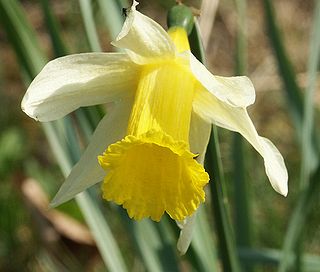
Narcissus pseudonarcissus, commonly named the wild daffodil or Lent lily, is a perennial flowering plant.
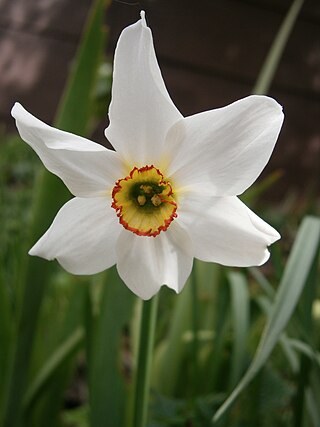
Narcissus poeticus, the poet's daffodil, poet's narcissus, nargis, pheasant's eye, findern flower or pinkster lily, was one of the first daffodils to be cultivated, and is frequently identified as the narcissus of ancient times. It is also often associated with the Greek legend of Narcissus. It is the type species of the genus Narcissus and is widely naturalised in North America.

Narcissus triandrus, also known as the Angel's Tears daffodil, is a species of flowering plant within the family Amaryllidaceae.

Narcissus jonquilla, commonly known as jonquil or rush daffodil, is a bulbous flowering plant, a species of the genus Narcissus (daffodil) that is native to Spain and Portugal but has now become naturalised in many other regions: France, Italy, Turkey, the former Yugoslavia, Madeira, British Columbia in Canada, Utah, Illinois, Minnesota, Ohio, and the southeastern United States from Texas to Maryland.

Narcissus bulbocodium, the petticoat daffodil or hoop-petticoat daffodil, is a species of flowering plant in the family Amaryllidaceae, native to southern and western France, Portugal, and Spain. Some sources say that the species is also native to Morocco, but this is based on populations formerly thought to be varieties of N. bulbocodium but now regarded as separate species.

Narcissus cyclamineus, the cyclamen-flowered daffodil, is a species of flowering plant in the family Amaryllidaceae, native to North West Portugal and North West Spain.
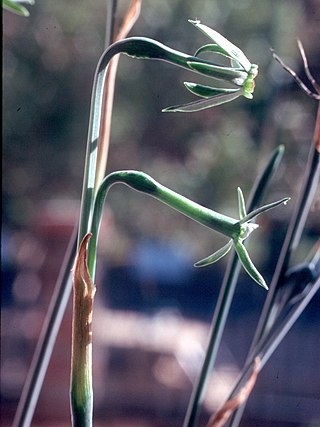
Narcissus viridiflorus, commonly known as campanitas, is a species of the genus Narcissus (daffodils) in the family Amaryllidaceae. It is classified in Section Jonquillae.

Narcissus gaditanus is a species of the genus Narcissus (daffodils) in the family Amaryllidaceae. It is classified in Section Juncifolii, and is native to the southern Iberian Peninsula.

The taxonomy of Narcissus is complex, and still not fully resolved. Known to the ancients, the genus name appears in Graeco-Roman literature, although their interest was as much medicinal as botanical. It is unclear which species the ancients were familiar with. Although frequently mentioned in Mediaeval and Renaissance texts it was not formally described till the work of Linnaeus in 1753. By 1789 it had been grouped into a family (Narcissi) but shortly thereafter this was renamed Amaryllideae, from which comes the modern placement within Amaryllidaceae, although for a while it was considered part of Liliaceae.
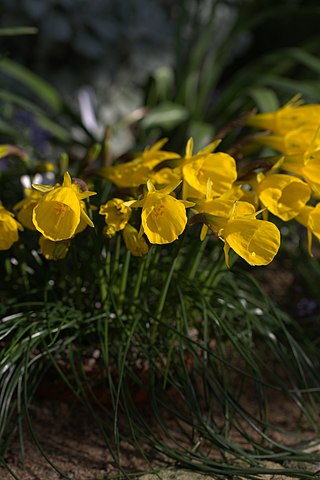
Narcissus obesus is a species of the genus Narcissus (Daffodils) in the family Amaryllidaceae. It is classified in Section Bulbocodium. It is native to Spain, Portugal and Morocco.

Narcissus abscissus is a species of the genus Narcissus (Daffodils) in the family Amaryllidaceae. It is classified in Section Pseudonarcissus. It is native to France and Spain in the region of the Pyrenees.
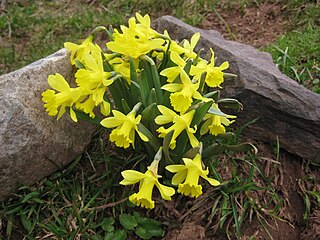
Narcissus jacetanus is a species of the genus Narcissus (daffodils) in the family Amaryllidaceae. It is classified in Section Pseudonarcissus. It is native to northern Spain around Pamplona. It is found on calcareous soil.

Narcissus minor, the lesser daffodil or least daffodil, is a species of Narcissus within the family Amaryllidaceae. The species and its cultivar 'Little Gem' have both gained the Royal Horticultural Society's Award of Garden Merit.
Aethionema subulatum is a species of stonecress in the family Brassicaceae. It is native to Turkey.
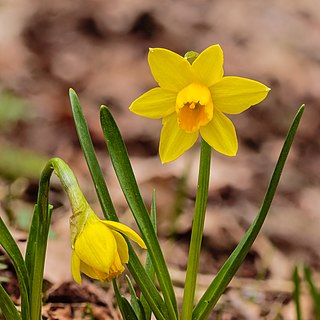
Narcissus 'Tête-à-tête' is a hybrid cultivar of Narcissus, which was introduced in 1949. It is one of 110 cultivars produced by British daffodil breeder Alec Gray. 'Tête-à-tête' is a popular ornamental plant, which is known for its very early flowering period and short stature. This cultivar is commonly used as a garden plant where it can be planted in pots, rock gardens, garden borders and even naturalized in lawns. The cultivar name 'Tête-à-tête' means to have a conversation between two people, which relates to the cultivar often hosting a pair of flowers per stem.

Narcissus 'Rip van Winkle' is an heirloom cultivar of Narcissus, which was first introduced commercially in 1884. When the cultivar was produced is unknown, however it is believed this historic cultivar originated in Irish gardens. The cultivar was first distributed by plantsman William Baylor Hartland of Country Cork, Ireland.



















